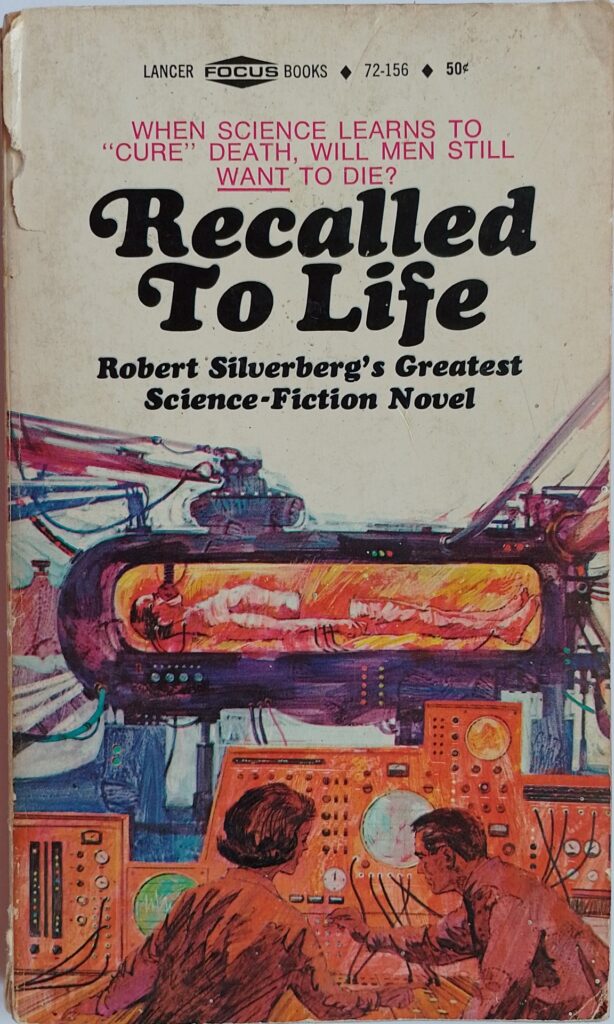First published 1958. Focus paperback, 1967, pp 144, c.50,000 words.
Amongst a small pile of a friend’s husband’s old SF books given to me I found two by Robert Silverberg whom I had never encountered before. What a treat this is for fans of the golden age of science fiction.
The story centres around the discovery of a process for reviving recently deceased people – so much is well worn territory from Frankenstein on. However what we have here has very little to do with the process itself or the act of discovery. Instead it concerns the public reaction.
The protagonist is a lawyer, James Harker, brought in by a secretive foundation that has cracked the process. He is to prepare the way for public acceptance. Harker was a prominent politician, a former governor of New York state, who fell out with his party over reforms and has now retired to private practice. He has much to prove and sets to work testing the waters amongst friendly contacts in the religious establishment and politics. Unfortunately the worst enemies are on the inside.
Silverberg does a fascinating job of exploring possible reactions to such a discovery. One might not agree with how all the various strands would play out, but the set presented here are coherent and distinctly plausible.
It’s always fascinating reading future-set fiction from the distant past: how somethings turn out as predicted and others miss the mark. This is set in 2033 [p5] and was written around the time of Sputnik, so at least rockets were a known technology. Here, both Americans and Russians had walked on the moon in the early 1960s, and an American had first stood on Mars in 1984 (a sub-plot involves the death of the first man to do so). International settlements are established on both the Moon and Mars and seen as models of cooperation and scientific rationalism – a common dream amongst the science minded.
Some of the technological details described are interesting fantasies, like the doors that split in two, half opening up and half down – real spaceship stuff in a normal office. Windows can be ‘opaqued’ [p7] to keep out solar glare. Lifts have been replaced by ‘gravshafts’ [p12]. New York is served by monorails [p13], and its air purified by massive ‘puriton stations’ [p12]. Other aspects are straight out of the 1950s and don’t appear to have moved on in the eighty years since. Most notably is the absence of women in any roles other than wives and secretaries. Other stuck-in-the past aspects include the telephone system (no mobile phones), smoking everywhere – although Harker uses a rather natty finger-tip lighter. The laboratories Harker visits are old fashioned he notes: ‘the lighting, was of all things, by incandescent bulbs; the air-conditioners were noisily evident’ [p21]. Harker is given a lift in what seems to be a fancy new car: ‘a long, low, thrumming ’33 turbo-job, sleekly black and coming with a $9000 pricetag at the least.’ [p19], so no electric, self-driving cars in this future, but at least they are cheap.
Silverberg has an occasional laconic, Chandler-esq turn of phrase: ‘Helen Bryant, oldest of the daughters, sat solicitously by her father’s bedside, glaring at him with the tender solicitude of a predatory harpy.’ [p14]. He is also understanding of human behaviour, which is something that has not changed in the intervening years: ‘It was fast becoming a contest between darkness and light, between education and ignorance – a contest complicated by the presence of educated, intelligent, utterly sincere fanatics in the camp of the opposition.’ [p87]
Silverberg writes very clearly, without any literary pretentions. It makes for easy reading. There is fun to be had in the technological and social details of this imagined future. But the main strength of the book is in its exploration of the impact of the well-worn trope of revivification. Had he been writing this today his conclusion would most likely be much more cynical and darker, but he was writing in the bright technological promise of the 1950s. An entertaining and gently thought-provoking tale.
Wikipedia biography of Silverberg: https://en.wikipedia.org/wiki/Robert_Silverberg
Others’ reviews of the book: https://www.goodreads.com/book/show/2353311.Recalled_to_Life?ref=nav_sb_ss_4_16
© William John Graham, June 2023

